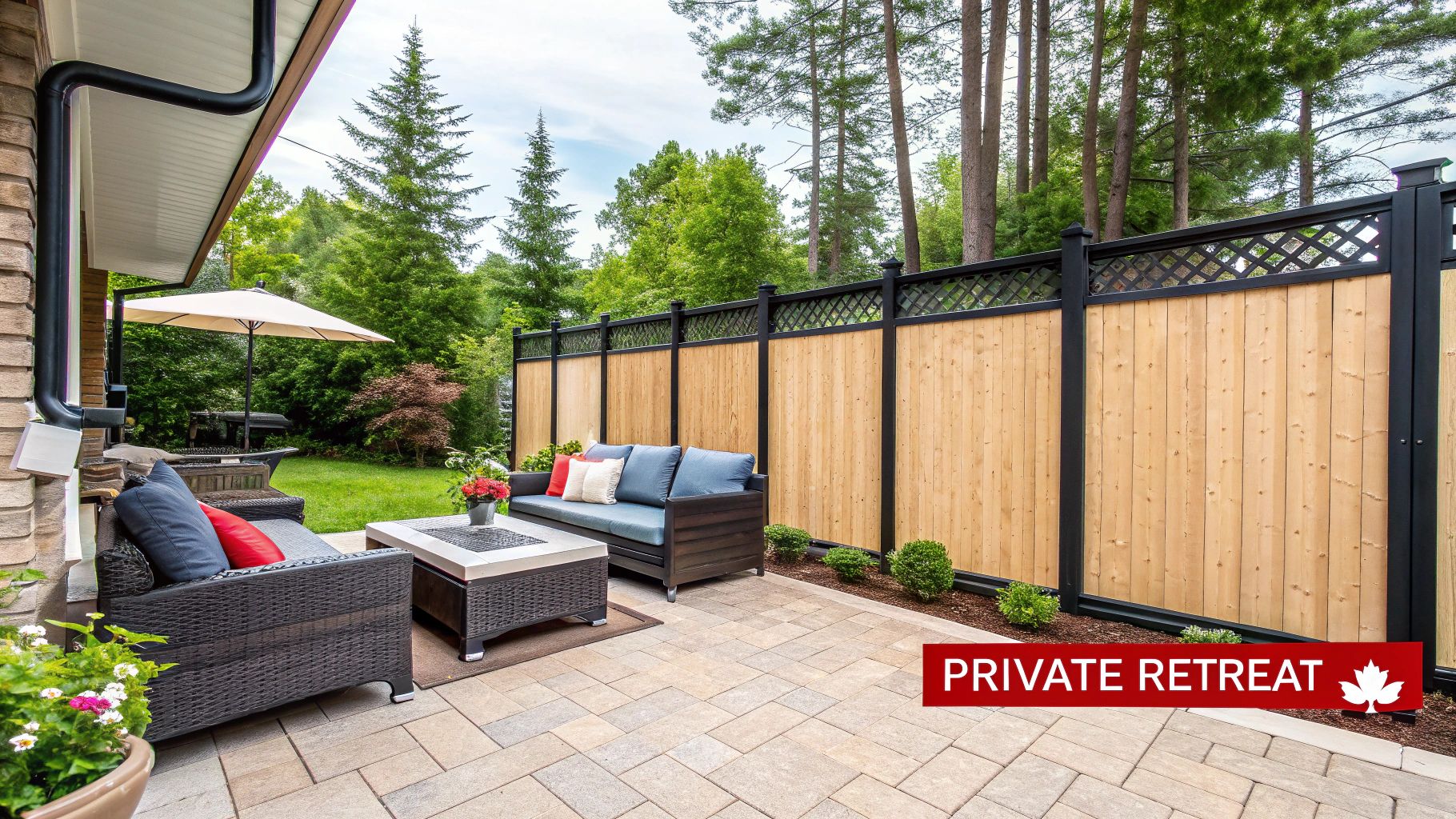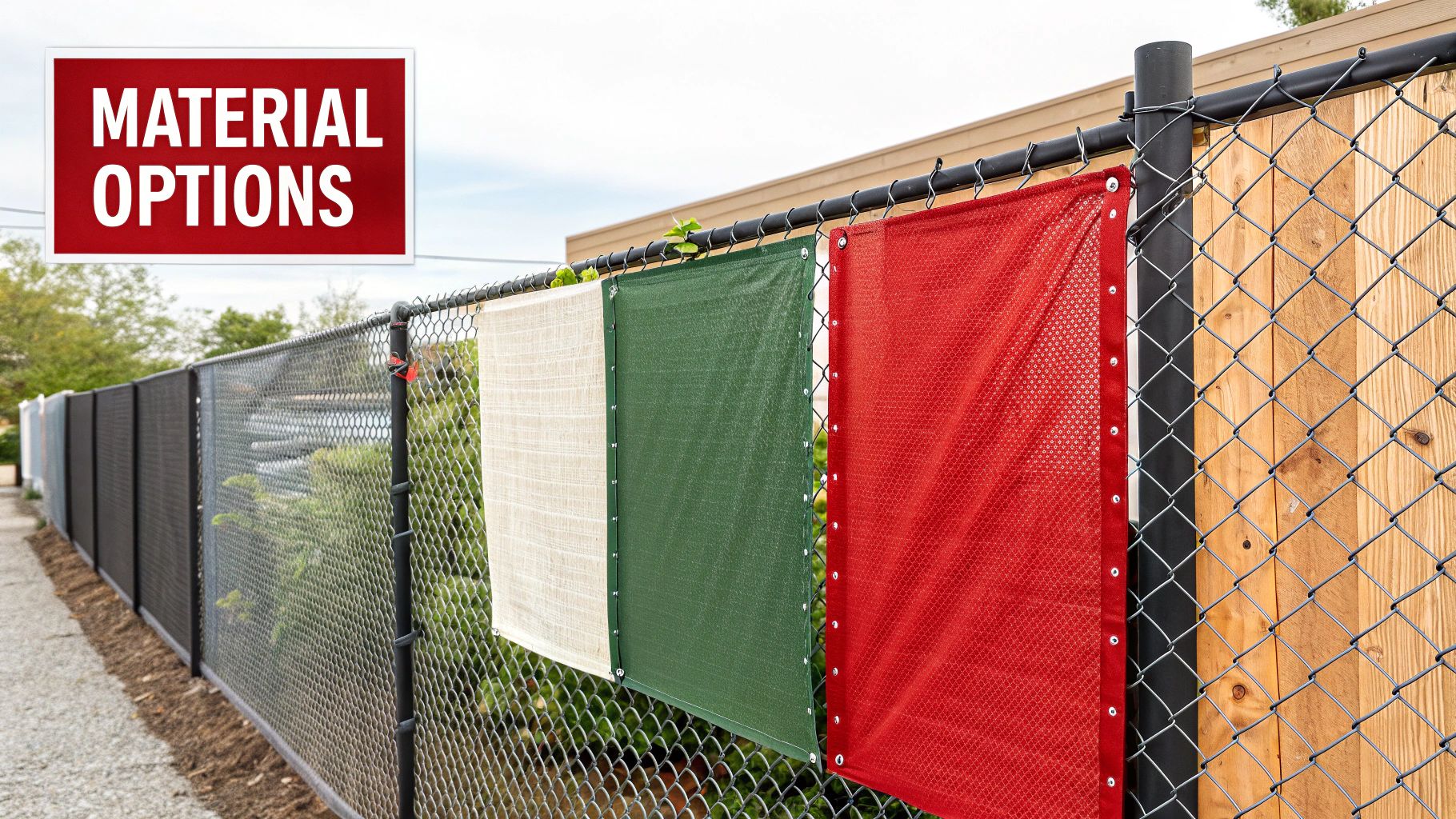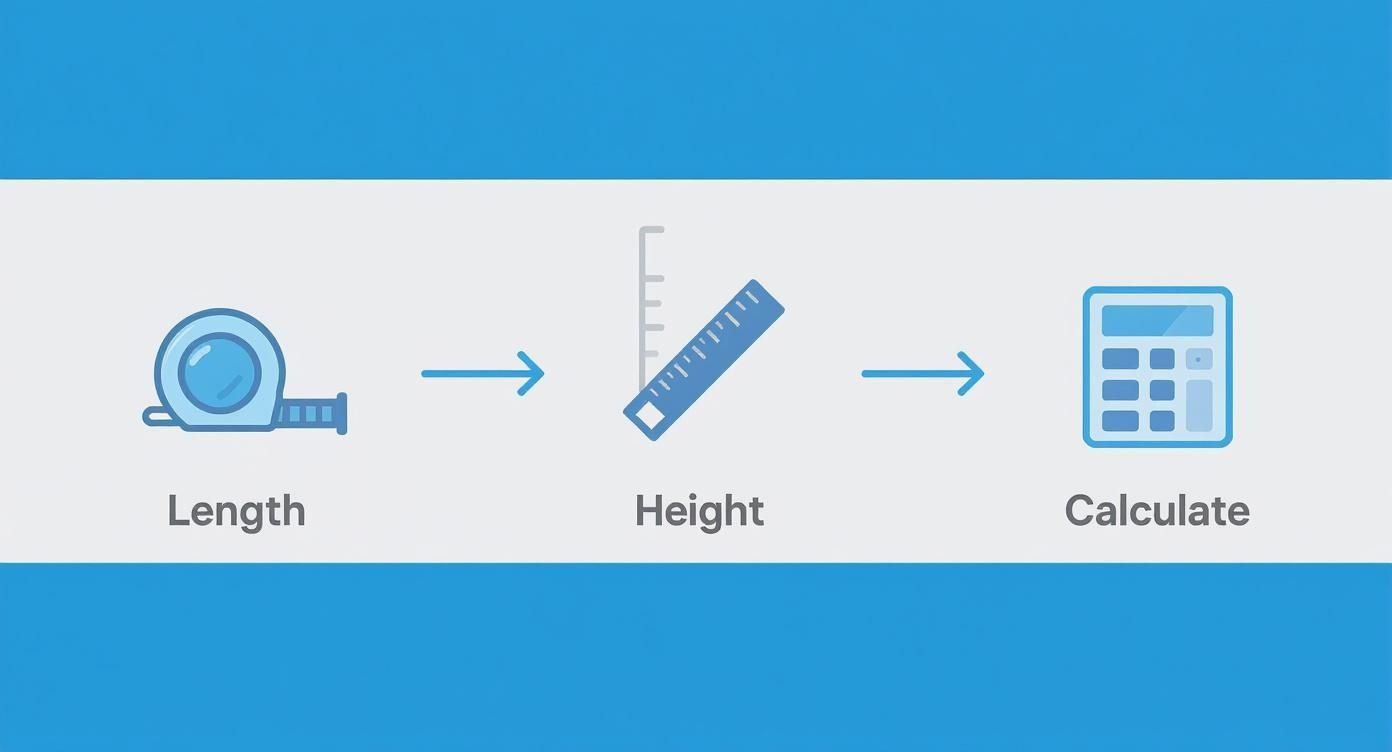Feeling a bit too close to your neighbours? A fence privacy screen is one of the quickest, most affordable ways to get your outdoor space back. It's a simple addition that attaches straight onto your existing fence, turning an open yard into a private retreat.
This isn't just about blocking wandering eyes, either. A good screen can secure a commercial site from unwanted attention or simply give a tired old fence a clean, modern facelift.

Think of it as a smart investment in your lifestyle and security. We’ll get into why quality really matters, especially with our tough Aussie conditions, and how choosing a durable screen now saves you a lot of headaches later on.
Whether you're trying to enjoy a quiet weekend in the backyard or securing a busy construction site, controlling who sees into your space is essential.
A quality fence privacy screen delivers some serious benefits:
It's no surprise the demand for these solutions is on the rise. In fact, the Australian commercial and industrial fencing market hit around $985.10 million AUD in 2024 and is set to keep growing. This trend really highlights how much Aussies are focusing on security and privacy.
Of course, before you jump into any outdoor project, it’s always a good idea to know how to budget for your home improvement projects to make sure everything goes smoothly.
At Super Rack, we get that every property has different needs. That’s why we offer expert advice to help you find the perfect privacy solution, backed by top-quality materials and competitive pricing. With fast, nationwide delivery, you can get your project started sooner.
The material you pick for your fence privacy screen is the single biggest factor in how it looks and performs over time. It dictates everything from durability and maintenance to how well it copes with the harsh Aussie sun and wind.

Get this choice right, and you won't be replacing it after just one or two seasons. Think about your main goal. Is it maximum privacy for a worksite, or a more subtle, attractive screen for your backyard?
For example, a construction site manager in Sydney needs a rugged, high-blockage material to secure expensive equipment. But a homeowner in suburban Melbourne might just want a screen that blends nicely with their garden while keeping the neighbour’s view at bay.
High-density polyethylene (HDPE) shade cloth is, without a doubt, the most popular and practical material for a fence privacy screen. It’s tough, versatile, and built to last in Australian conditions.
The best shade cloth is treated for UV resistance, which is completely non-negotiable under our sun. Without it, the material can go brittle and fade in a surprisingly short amount of time. This is a key reason to choose a quality supplier like Super Rack, as our products are designed for superior longevity.
Here’s why it’s a top pick:
A common mistake I see is people buying cheap, untreated material that degrades within a year. Investing in a high-quality, UV-stabilised fence privacy screen ensures you get a solution that lasts, saving you money and hassle in the long run.
While shade cloth is a brilliant all-rounder, other materials can serve different purposes, especially if you're after a specific aesthetic. You can learn about the different types of wood for fences, which might be an option if you're building more permanent, decorative structures.
However, when it comes to attaching a screen to existing structures like our versatile temporary fence panels and mesh—often used on sites and at events—shade cloth remains the most effective and efficient choice. It's just so much easier to install and handle.
Getting your measurements right is probably the single most important step for a professional-looking fence privacy screen installation. It's the difference between a neat, taut finish and one that sags and just doesn't look right. The good news? You don't need to be a tradie to get it spot on.
A bit of prep work here will save you a world of headaches later on. Ordering the right amount of material from the start means no last-minute trips for more, and you won't be stuck with a pile of unusable offcuts. It also ensures you get the best value for your money, which is something we focus on at Super Rack with our competitive pricing.
Before you start, grab a few basic tools. Having everything ready to go will make the whole process much smoother and quicker.
You’ll need:
That's really all it takes. No fancy gear, just simple tools to make sure you get it right the first time.
Start at one end of your fence and measure the entire length in metres. For a simple, straight run of fencing, this is a breeze—just extend your tape from one end post to the other.
If your fence line has corners, like in an L-shaped backyard, measure each section on its own. For instance, if one side of your yard is 15 metres long and the back fence is 20 metres, write down both numbers. Then, just add them together (15m + 20m = 35m) to get your total length. Always a good idea to measure twice to be sure!
Pro Tip: Don’t bother subtracting the width of any gates from your total length. It's often much easier and gives a cleaner finish to run the screen right across the gate and simply cut a neat slit for the latch. This creates a seamless look and keeps your privacy uninterrupted.
Next up, measure the height of your fence. For most standard fences, you'll want to measure the distance from the top rail to the bottom rail. Try to avoid measuring all the way to the ground. Leaving a small gap at the bottom is a great trick for improving airflow and stopping the screen from bunching up with leaves and debris.
For example, if your fence panel is 1.8 metres high, a fence privacy screen that's just a fraction shorter, say 1.75 metres, is often the perfect fit. This ensures it hangs cleanly without dragging on the ground.
Here at Super Rack, we stock a variety of screen heights designed to match common fencing standards all over Australia. Our team is always on hand to give you some friendly advice on the best fit for your particular fence, making sure you get a flawless result every time.
Alright, ready to get that screen up? Installing a fence privacy screen is a perfect weekend DIY job. With just a few simple tricks, you can get a professional, taut finish that looks brilliant and stands up to whatever the Aussie weather throws at it.
We'll walk you through the whole process, from prepping your fence to securing that last corner. The focus here is on using cable ties the right way to get that clean, sag-free look everyone’s after. Let's get it done right the first time.
Before you even think about unrolling your new screen, a little bit of prep work will make a world of difference.
First up, give your fence a quick once-over. Are the posts solid? Any loose wires or panels? It's much easier to fix these things now than after the screen is on.
Next, get your tools together. You don't need much:
Once your fence is checked and your tools are ready, you’re good to go.
The absolute key to a flawless look is tension. Start at one end of your fence and fix the top corner of the screen with a cable tie. Now, work your way along the top rail, pulling the screen tight as you go and feeding a cable tie through each eyelet.
Pro Tip: A common mistake is to attach the entire top run first, then do the bottom. For a much better result, work in smaller sections. Secure a metre or so along the top, then pull the screen down firmly and attach the bottom before moving to the next section. This simple trick prevents wrinkles and keeps the tension even across the whole panel.
As you go, try to keep the spacing consistent. A good rule of thumb is to place a tie every 30-50 cm along the top, bottom, and sides. If you’re in a particularly windy spot, chuck in a few extra ties for good measure. It can't hurt.
This simple infographic breaks down how to measure up before you even place your order, making sure you get exactly what you need.

Getting the measurements right from the start means no wasted material or money. Easy.
It's this focus on security that’s fuelling major growth in the wider fencing industry. The Australian fencing market was valued at $459.76 million AUD in 2025 and is tipped for steady growth, showing a clear national trend towards better property protection.
For bigger jobs, like securing a worksite, the principles are the same but even more critical. A secure installation is non-negotiable when you're dealing with long stretches of temporary fencing for construction.
Once your fence privacy screen is all done, stand back and have a look. You've just boosted your privacy and given your space a fresh new look. With a quality product from Super Rack, delivered fast and nationwide, you can be sure your new screen will be there for years to come.
You've got your new fence privacy screen up, and it’s looking great. So, how do you keep it that way? The good news is, a little bit of straightforward care is all it takes to protect your investment and make sure you get years of performance out of it.
Of course, the best first step is choosing a high-quality, durable material from the get-go. Products from suppliers like Super Rack are designed for the tough Aussie climate, meaning they naturally need less upkeep and last a whole lot longer. Still, a quick check-up now and then is always a smart move.
For most quality shade cloth materials, cleaning is dead simple. You won’t need any harsh chemicals or fancy gear.
Most of the time, a gentle hose-down is all you need to wash off dust, dirt, and any cobwebs that have made themselves at home. If you come across a more stubborn spot, like bird droppings, a bucket of mild, soapy water and a soft brush will sort it out. Just give it a light scrub and rinse it off well.
One of the biggest mistakes people make is hitting it with a high-pressure washer. It might seem like a quick fix, but that intense spray can easily damage the fabric's weave, stretch the material, and even strip away its UV protective coating. Gentle is always the way to go.
Doing this simple routine once or twice a year will keep your screen looking its best and stop any grime from building up over the long term.
We're no strangers to wild weather in Australia, and a big storm is the perfect prompt for a quick fence inspection. Once the wind and rain have settled down, take a walk along your fence line and keep an eye out for a few key things.
Spotting these little issues early stops them from becoming bigger, more expensive problems later on.
Found a small problem? No dramas. Most minor repairs are a quick and easy DIY job.
If you spot a broken cable tie, just snip it off and pop on a new, heavy-duty UV-resistant one. It’s a great idea to keep a small pack of spares handy for this very reason.
For a small tear in the fabric, you can often patch it up with a specialised repair kit. In a pinch, you can even use a few extra cable ties to secure the torn area and stop it from getting any worse. A little proactive effort ensures your fence privacy screen stays a tough and effective barrier for years to come.
Need advice on the best materials for longevity? The expert team at Super Rack is here to help, offering practical guidance and nationwide service to keep your property looking its best.
When you're looking to boost the privacy around your property, a few questions always seem to come up. Getting straight, practical answers is the key to choosing the right product with confidence.
We've pulled together the most common queries we hear about fence privacy screens to help you get started on the right foot, whether it's for a quiet backyard or a busy commercial site.
The real answer comes down to the material's blockage rating. Most quality fence privacy screens you'll find will offer somewhere between 70% to over 90% visual blockage. That's more than enough to seriously obscure the view, making them perfect for backyards, construction sites, or events where you need to create a secluded zone.
If you're after maximum seclusion, you'll want to aim for a higher percentage. The trick is finding the right balance between privacy, airflow, and light so you get the result you want without feeling completely boxed in.
For the most part, yes. Privacy screens are incredibly versatile and work best on fences you can see through. Think chain-link, wire mesh, and of course, temporary fencing panels.
The most important thing to check is that your existing fence is strong enough to handle the screen, especially when the wind picks up. Before you start, just give your fence posts and panels a quick once-over to make sure they're secure and in good shape. A sturdy foundation is everything for a safe, long-lasting installation. You'll find that a quality fence privacy screen fits perfectly with most systems, like the versatile temporary fencing options we supply nationwide.
The cost can vary quite a bit, depending on the material, height, and the total length you're trying to cover. In Australia, it's almost always priced per linear metre. A standard roll of good-quality shade cloth, for instance, will have a different price point than a heavy-duty, decorative option.
At Super Rack, our focus is on providing top-notch quality at competitive prices. The best way to budget for your project is to get a quote based on your specific measurements. That way, you know exactly what you're paying for, with no surprises down the track.
This is a really valid concern, especially in parts of Australia where strong winds are just a part of life. A fence privacy screen does add surface area, which naturally catches more wind.
However, good screens are made from breathable, woven materials designed to let air pass through, which massively reduces the strain on your fence. The real key here is proper installation. Using plenty of heavy-duty, UV-resistant cable ties and making sure the screen is pulled taut helps distribute that wind force evenly. For very windy spots, you might even consider adding some fence braces for that extra bit of support and peace of mind.
Ready to reclaim your outdoor space? The expert team at Super Rack is here to help you find the perfect fence privacy screen for your needs. With superior quality, competitive pricing, and fast nationwide delivery, we make it easy to get the job done right.
Browse our range of fencing solutions or get a custom quote today!
4000 to 4182
4186 to 4207
4300 to 4305
3000 To 3096
3098 To 3112
3114 To 3138
3140 To 3157
3161 To 3198
3200 To 3207
Let's connect